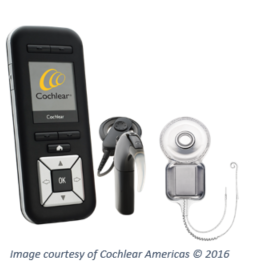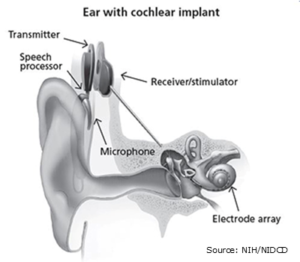WHAT IS A COCHLEAR IMPLANT?
 A cochlear implant is a small, safe, electronic device approved by the FDA that can help to provide a sense of sound to a person with moderate to profound hearing loss in one or both ears, who is receiving little or no benefit from hearing aids.
A cochlear implant is a small, safe, electronic device approved by the FDA that can help to provide a sense of sound to a person with moderate to profound hearing loss in one or both ears, who is receiving little or no benefit from hearing aids.
The implant consists of an external portion that sits behind the ear and a second portion that is surgically placed under the skin and in the cochlea to channel electrical stimulation to the auditory nerve, bypassing any damage to or maldevelopment of the auditory structures inside the inner ear.
From a cosmetic standpoint, cochlear implant speech processors are modest in size, like hearing aids, and designed to be as visibly undetectable as possible. Device options currently include technology for noise management and Bluetooth connectivity, and continue to evolve.
HOW DOES A COCHLEAR IMPLANT WORK?
 While hearing aids and other assistive listening devices simply amplify sounds, a cochlear implant transforms speech and other sounds into electrical energy that is used to stimulate the auditory nerve.
While hearing aids and other assistive listening devices simply amplify sounds, a cochlear implant transforms speech and other sounds into electrical energy that is used to stimulate the auditory nerve.
Cochlear implants have both external (worn outside the body) and internal (inside the skull) components.
An implant is typically comprised of these parts:
• A microphone
• A speech processor
• A transmitter & receiver/stimulator
• An electrode array
FOLLOWING THE SOUND PATH…
- Sound is picked up by the microphone and is converted into a coded electrical signal.
- This coded signal is sent by the transmitting coil of the speech processor to the receiving coil of the internal receiver/stimulator (the implant).
- The implant sends the coded electrical signal to the electrode array, which is implanted into the cochlea (inner ear). The array is a group of electrodes that collects the impulses from the stimulator and sends them to different regions of the auditory nerve.
- Multiple channels and points of stimulation now fire in a pattern that the cochlea can recognize stimulating the acoustic nerve ending in the cochlea.
- The auditory nerve picks up these signals and transmits them to the brain (auditory cortex) where they are perceived as sound.
It is important to distinguish that a cochlear implant does not restore “normal” hearing. Instead, it can give a person with hearing loss a useful representation of sounds and help him or her to understand speech.
